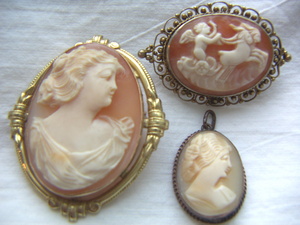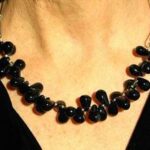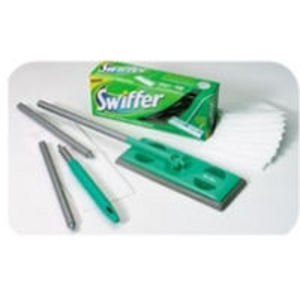Cameos have been beloved adornments for over 2000 years. The most popular “real” cameos are considered to be those carved out of shell or hardstone like agate, carnelian, and onyx. In fact, expertly carved hardstone cameos are much more valuable than their shell counterparts. However, there are many other natural materials that cameos can be made from. These include gemstones, ivory, lava, coral, jet, and mother of pearl.
Many people don’t realize that vintage costume jewelry “fake” cameos, which are made out of manmade materials like glass, plastics (nowadays hard resins) and ceramics, can command prices that compete with those of “real” or natural cameos. In addition, many “fake” cameos are combinations of two or more materials, such as molded celluloid (an early plastic) glued onto glass or stone.
It all depends on the maker, scarcity, and desirability of the plastic cameo to the costume jewelry collector. There are some Bakelite plastic cameos from the 1930s and 1940s that are currently commanding higher prices than expertly carved shell cameos! In addition, to further complicate matters, many vintage costume jewelry designers incorporated real cameos (shell and hardstone) into their designs.
Are you totally confused yet? Don’t be! Just know what type of cameo you wish to buy-“real” or “fake,” and become familiar with the traits of both types. Start by learning to recognize the characteristics of one or two materials first. I recommend learning the traits of ever so popular shell cameos first, as there is a wealth of information about them both online and off.
The best modern shell cameos come mainly from Italy. They are still carved by families of expert carvers and their apprentices who have been carving cameos there for hundreds of years. (Most modern stone cameos are made by expert carvers in Germany.)
The trouble comes about when a modern resin cameo from China (which is intricately carved and can look just like a shell cameo) is passed off as “real”. Then, there is a legitimate issue with the “fake” because it has been offered as “real” and often offered at the same price a real shell cameo would command.
So how does one properly distinguish between a real shell or hardstone cameo and a plastic or resin imposter? Listed below are some helpful tips:
1. You can see a wide assortment of modern resin cameos from China here. Once you know the designs of these fake cameos, you will be less likely to be fooled into buying one that has been deliberately or mistakenly advertised as real.
2. Real shell cameos have a matte look to them, not a glossy or shiny look that a lot of vintage plastic cameos have.
3. Turn the cameo over and inspect the back. Real shell cameos have concave (curved) backs. Think of the shape of a conch shell from which they are generally carved from the outside to the inside. Those shells are all concave (curved).
4. Shell cameos have a wonderful translucent quality, like porcelain, when held up in a strong light or sunlight. From the back you will see the entire silhouette of the design. Some plastic cameos may be thin enough to see through like this, so don’t rely on this as your only test.
5. Always inspect the cameo you are going to purchase under a jeweler’s 10X loupe, regardless of the material. Look for tool carving marks in real shell cameos.
6. Some people can tell by touching a cameo to their wrist, chin, or tooth (I don’t recommend this) if it is shell or stone (gives a cold sensation )as opposed to plastic (gives a warm sensation). I am not sensitive enough to rely on this method. Also, many cameos are too small to “feel” them accurately.
7. Because fake cameos that have been glued together layer by layer may contain real and fake materials combined, they may be extremely hard to detect. If the cameo you are considering is suspect, and/or the asking price is very high, you should consider having a jeweler in your area examine the piece for authenticity.
8. Again, the best advice I can give you is to review many photos of cameos for sale online and inspect many real cameos of the material and time period you desire to purchase. (Make sure you visit a reputable dealer!) In time, you will be much better equipped to judge whether or not a cameo is “real” or “fake”.
Note:
Please don’t try the old test of poking the piece with a hot needle, which in theory would go through any plastic easily, but not shell or hardstone. If the piece is old and made of a soft plastic, you will damage it. If the piece is newer, many modern resins are so hard the needle won’t pass through them, so this test won’t reveal anything about them!
Sources:
1. Personal Experience
2. “Cameo Jewellery Guide,” sites.google.com/site/cameojewellery/.
3. “The historical Cameo,” victorianbazaar.com/cameos.html.
4. “Italian Cameos,” cameosnow.wordpress.com/.
5. “Italian Cameo Jewelry,” squidoo.com/Italian-Cameo-Jewelry.
6. “Cameo Heaven Tutorial,” cameoheaven.com/tutorial.html.
7. “resin cameo – resin cameo products manufacturers on alibaba.com,” alibaba.com/showroom/resin_cameo.html.
8. “What is a real Cameo?” oneofakindwis.com/2008/vintage-jewelry/what-is-a-real-cameo-vintage-plastic-cameo-or-antique-shell/.
9. “Identifying Valuable Cameos,” ezinearticles.com/?Identifying-Valuable-Cameos&id;=995927.






